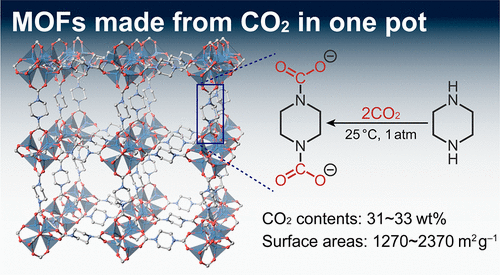
京大アイセムス:CO2を常温常圧で変換:多孔性材料(PCP/MOF)(動画):
Kyoto Univ: Converts CO2 at normal temp pressure:Porous material (PCP/MOF):
京都大学 icems:在常温常压下转化 CO2:多孔材料 (PCP / MOF)
−カーボンニュートラルの新手法−
京都大学アイセムス
JEOL RESONANCE
理研研究グループは、
CO2を「常温・常圧下において、有用多孔性材料(PCP/MOF)に変換する」という、新手法開発に成功しました。
従来の問題点:
- CO2を有用な材料に変換するには、
- 高温・高圧下での反応や、
- 高価な貴金属触媒の使用が必須でした。
今回の新開発:
研究グループは、
- アミンという有機分子と、CO2を反応させます。
- 得られた有機分子を、直接金属イオンと反応させ、
- 一度に、PCP/MOFを合成できる新手法を開発しました。
PCP/MOFへ変換:
アミンと金属イオンの組み合わせを、工夫しました。
常温・常圧のCO2を、さまざまなPCP/MOFへ変換できます。
分子レベルの構造解析:
「放射光X線回折測定と固体核磁気共鳴分光法(NMR)を使った解析」を実施しました。
- PCP/MOFの分子レベル内部には、1 nmの細孔が規則的に形成。
- その構造は、重さあたり30%以上がCO2からできていることが判明。
本ソリューションの用途:
金属イオンとアミンの組み合わせを工夫することで、
- さまざま構造・機能の多孔性材料合成や、
- 不純物を多く含む工場排ガスのCO2など、
- 資源化対象の拡大が、期待されます。
多孔性材料とは:
その内部にミクロな⽳(細孔)を無数に持つ固体のこと。
「浄⽔器や空気清浄機に⼊っている活性炭やゼオライト」はその例です。
近年ますます多孔性材料の 研究は発展しています。
エネルギー貯蔵からガス分離まで幅広い分野で⽤いられています。
PCP/MOF に着目:
本研究 では、多孔 性材料である PCP/MOF に着目しました。
PCP/MOFは、「⾦属イオンと有機分⼦(架橋性配位⼦)からなるジャングルジムのような構造」を持ちます。
PCP/MOF は 、90 年代後半に発⾒されて以来、90,000 以上の種類が開発されました。
その⼀部は、半導体ガス貯蔵⽤途などへ実⽤化されています。
CO2を原料として、PCP/MOF合成:
しかし、そ のいずれにおいても、CO2を原料として作られたことはありませんでした。
この理由は、「 PCP/MOF 合成に適した、架橋性配位⼦を CO2から簡便に作る⼿法」が、未探索であったためです。
ニュース | 京都大学アイセムス
https://www.icems.kyoto-u.ac.jp/news/6311/
常温・常圧で二酸化炭素の多孔性材料への変換に成功 | 理化学研究所
https://www.riken.jp/press/2021/20211008_2/index.html
One-Pot, Room-Temperature Conversion of CO2 into Porous Metal–Organic Frameworks
The conversion of CO2 into functional materials under ambient conditions
is a major challenge to realize a carbon-neutral society.
Metal–organic frameworks (MOFs)
have been extensively studied as designable porous materials.Despite the fact that CO2 is an attractive renewable resource,
the synthesis of MOFs from CO2 remains unexplored.
Chemical inertness of CO2
has hampered its conversion into typical MOF linkers such as carboxylates without high energy reactants and/or harsh conditions.Here,
we present a one-pot conversion of CO2 into highly porous crystalline MOFs at ambient temperature and pressure.Cubic [Zn4O(piperazine dicarbamate)3]
is synthesized via in situ formation of bridging dicarbamate linkers from piperazines and CO2 and shows high surface areas (∼2366 m2 g–1) and CO2 contents (>30 wt %).
Whereas the dicarbamate linkers
are thermodynamically unstable by themselves and readily release CO2,
the formation of an extended coordination network in the MOF lattices
stabilizes the linker enough to demonstrate stable permanent porosity.
Journal of the American Chemical Society